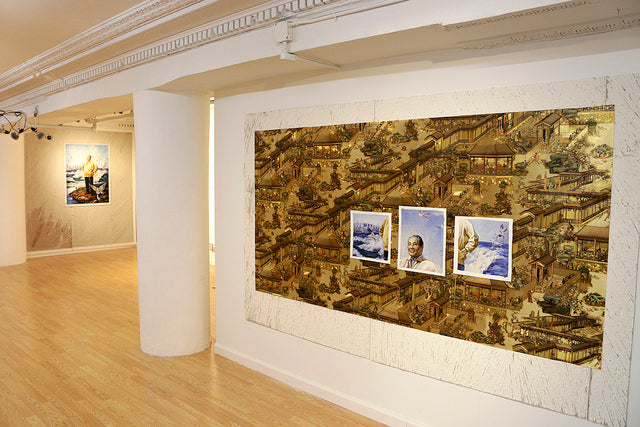
Artist-in-Residence Ben Sloat: Exploring History, Curating Experiences
Nothing of him that doth fade,
But doth suffer a sea-change
Into something rich and strange.
-- The Tempest
Former leader of the People’s Republic of China leader Deng Xiaoping stands proudly, surrounded by seagulls and ocean waves. In the distance is a shining metropolis. He wears, not a uniform, but a cozy cardigan fit for a kindly grandfather. His gaze is steady, his smile wry. What is he looking at? The image of himself broken into pieces? The sumptuous gold wallpaper depicting a China from the ancient past? You?
Our latest art exhibition, The Pearls That Were His Eyes, by multimedia artist Ben Sloat and curated by Julia Kirchmer, explores Chinese history, old and new, with layered and idealized images of both ancient and modern worlds. We had the chance to speak to Sloat about his work, the recurring themes of layers and hybridity, and how Pearl River and even its customers became part of his show.
Tell me about your background.
I grew up on Henry Street, where the Lower East Side meets Chinatown. As a multiracial Asian, this was an ideal situation with both Jewish and Asian communities.
Has New York been an influence on your work?
Definitely. New York is a place of constant change and renewal but with an undertone of history. The show reflects that too. It’s about things that are in transformation and seen in new ways. There are many layers, and ideas of hybridity and hybrid forms. The work is a unique combination of paintings combined with wallpaper and walls.
Were you always interested in art? How did your parents feel about that?
My parents are artists. But they do more traditional art while I take a more multi-media approach. My mom is from Taiwan and does printing, printmaking, and wood block prints. My father does oil painting and metal plate etchings. They actually met in art school in New York.
In college, I ended up studying international relations. I was interested in the complex relationship between the U.S. and China. There are similarities in some ways. They’re a similar size geographically. Both have a western frontier. But their population densities and cultural contexts are very different.
Did you get to go to China?
Yes, I first visited China when I was sever years old, and lived there again on a study abroad program in Beijing for a month in 1998.
The original Deng Xiaoping painting is from 1992 so just a few years before I was there. Being in China at that time was really exciting. Major shifts were very visible, and a new cultural wave was emerging. This show has that influence.
I did a fellowship in Beijing in 2012 and the hotel room I stayed in had the wallpaper I’ve used in the show. To me, the wallpaper represents a historical ideal. It’s solid except for the peepholes looking out at the present [Pearl River's main floor]. One aspect the show represents is a layered history.
How do your projects come about? Do you have a pretty clear idea of the end result and work toward it, or is it more of an evolution?
For this show, Pearl River was at least partly an inspiration. I love the history of it as a place. I have a personal relationship with it, having come here all through my childhood, and it’s had a great impact on New York history and culture.
As for Deng Xiaoping, he represents the opening of Chinese economy and the relationship with Chinese goods. I once received a mailing that was covered with these huge Deng Xiaoping stamps. I found them fascinating and started researching them. That’s when I learned about its propagandist history and landed on this painting.
Around the same time I was invited to submit a proposal for a show in Ireland. I wanted to incorporate Deng Xiaoping into that moment, and that became Package from China. Of course the Irish had a different interpretation of the show. They saw it as a cultural shift, a metaphor for what was happening internally in their own country.
In a lot of ways I’m like a curator. I don’t generate the materials but I commission and form them into artworks. I feel like people who come to Pearl River Mart are curators too. They’re curating objects into their personal lives.
It relates to a larger concern about finding objects that are meaningful and curating their own experiences. On Instagram, for example, people carefully curate images of themselves. Pearl River Mart has a unique arrangement of objects. Some are cheeky, some historical. Some are about the home, the body, different kinds of behavior. I think people feel like they identify personally with this location, and see it and its objects as extensions of their identities.
I see that you’re Director of the MFA in Visual Arts program at Lesley University in Cambridge, Massachusetts. What's that like?
The program is very community driven. Very high intensity since it's a low residency, and we meet twice a year for 10-day intensives. It’s meant to activate conversation through critique and seminar classes, and to teach students how to blend their lives with art practices. Directing the program is really a creative process in terms of shaping the culture of the program. And in terms of jobs to have while being an artist, it’s one of the best.
Have you had any jobs that you’ve hated?
I’ve had a number of jobs in the past, but I don’t think I hated any of them. My first job out of college was working for a movie archive and digitizing their movie stills. The work was interesting, but what I didn’t like was sitting in a chair all day. To be at a desk eight hours a day was a challenge.
I know you’re not on Instagram. Why is that?
I’ll probably join Instagram soonish. The idea of having more visual input is not exciting. I’m not quite convinced. It seems to be all about instant gratification. It doesn’t leave a deep footprint. And I find it limiting because of its uniformity. It’s always going to be in a certain form. For instance, you can’t have panoramic pictures or images with different proportions.
That’s the real value of a gallery space. It’s a direct experience. A visual and physical experience. Certain images are duplicated, giving a feeling of deja vu. Making the viewer ask, Did I just see that? The show is designed to be interactive, whether peeking through a hole in the wallpaper to the store below or seeing part of a painting from behind a wall.
Is there anything in particular now that you find inspiring or that you’re simply enjoying?
I find a ton of things interesting. I really like Stranger Things. There’s an element of nostalgia that’s interesting. It’s not even about the narrative. I think what people love are all the cultural details, the sound. For instance, there’s a Stranger Things synth pop collection on YouTube. How different would the show feel if even the font [of the credits] was different?
What inspires you? What do you do for inspiration?
I don’t like the term inspiration. I think there’s a really romantic idea that artists get inspired and are compelled to do this thing. It elevates the artist and makes the practice seem ungrounded. Idealized. It’s much more than that. There are certain things you chew on and try to figure out, like solving a problem.
Do you ever find yourself getting stuck?
Always! That’s always part of it. Most of what artists do doesn’t work. Some of it will never be finished. The public only sees the finished work. It’s a practice. It’s trying to figure things out. For this show I had a lot of possibilities. I started with twice as many things that are shown now. I had to edit it down because of the space. Just like a writer or musician. The show became meaningful in terms of the space. I like a nook that can be uncovered. You walk around and discover part of it. I thought, What am I going to do with these windows? And ended up using them as an asset.
Do you think the limits of the space forced you to be more creative?
Absolutely. It’s exciting to have a gallery at this height, looking down at the store and customers. It’s voyeuristic. I also love the columns and molding. The columns are like a pause between the walls, like a paragraph.
What I didn’t expect when I was installing was the chance to watch people shop. They seemed to come in with a very quiet and introspective mindset. They’re minding their own psychology. What is this object? Is this me? Where will it fit into my life? When you’re shopping, you don’t notice the other shoppers. To have the chance to do so — that was pretty interesting.
That extends to the gallery. Yes it’s about the art but it’s also about the whole experience.
The Pearls That Were His Eyes is on display in our TriBeCa location’s mezzanine gallery through January 2, 2018. To learn more about Mr. Sloat, visit his website.